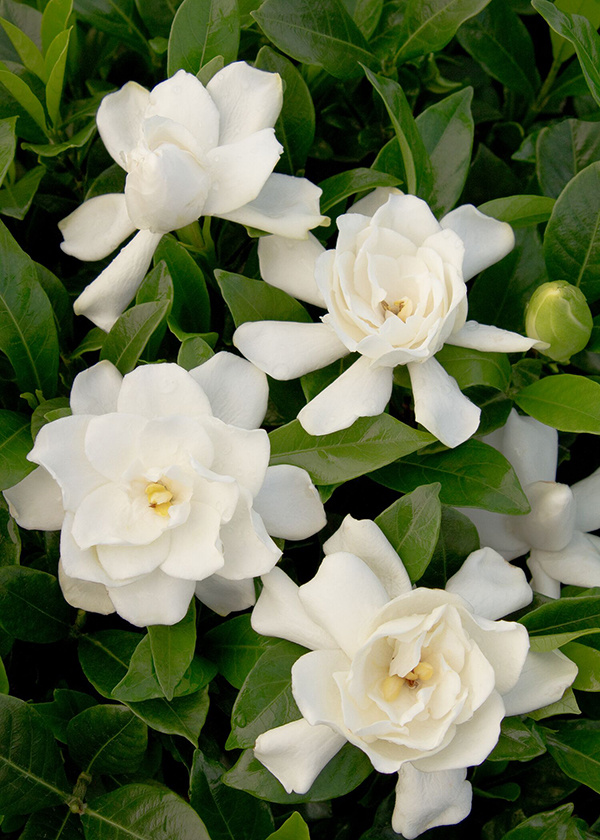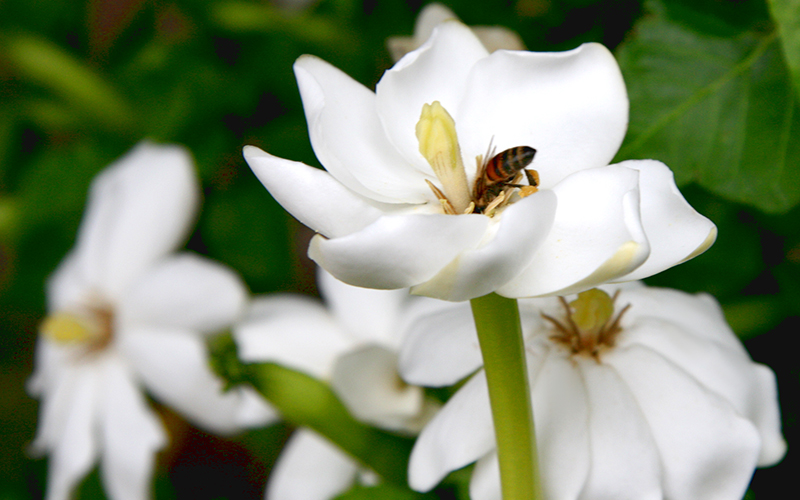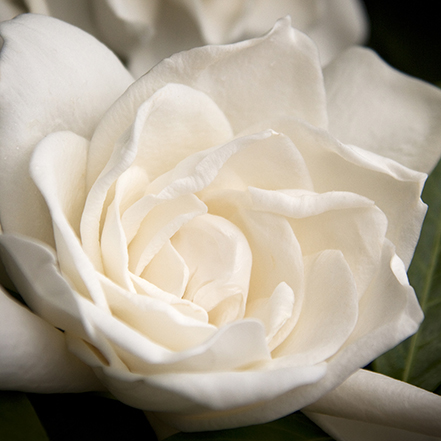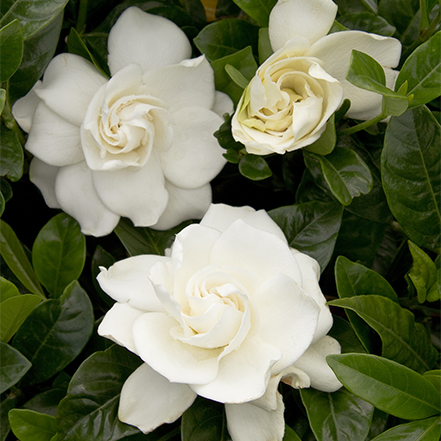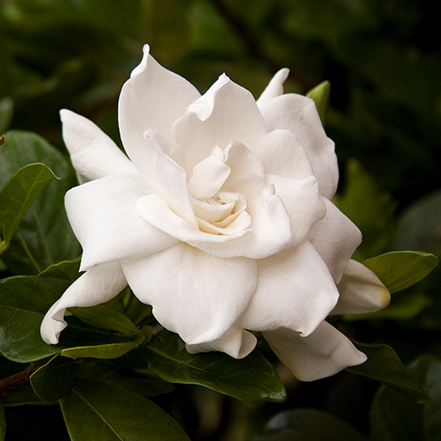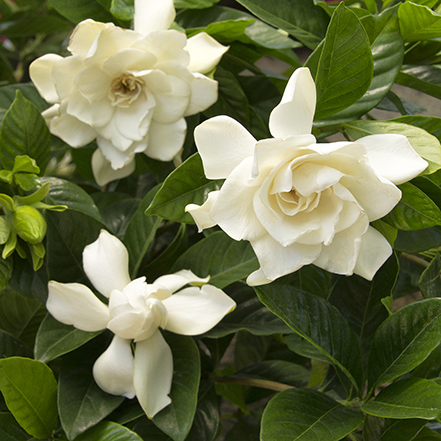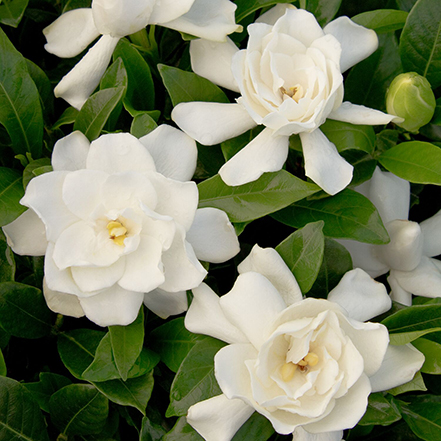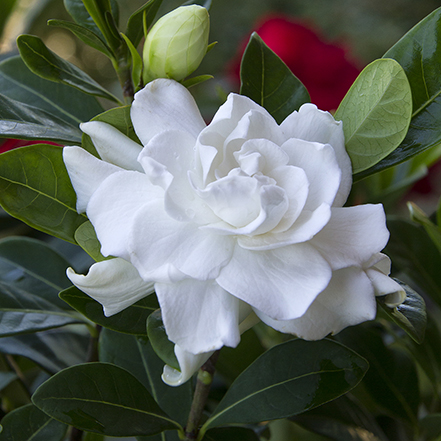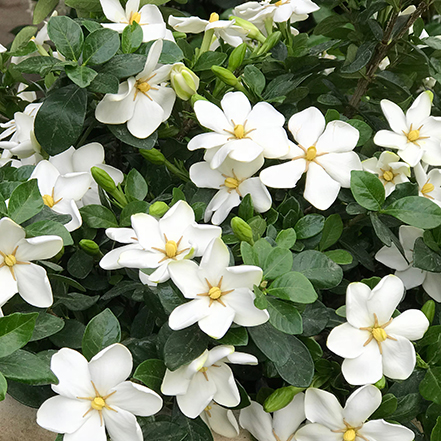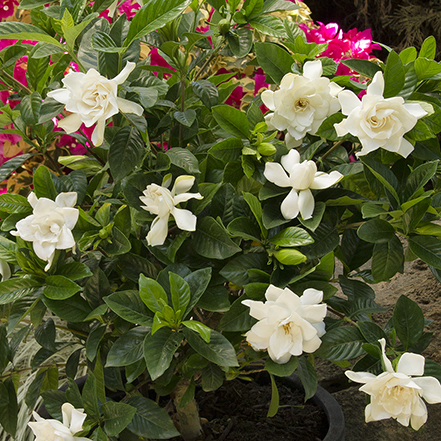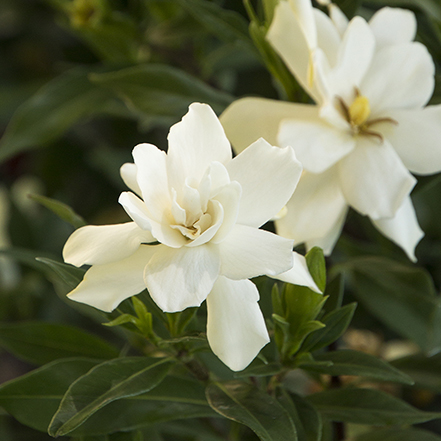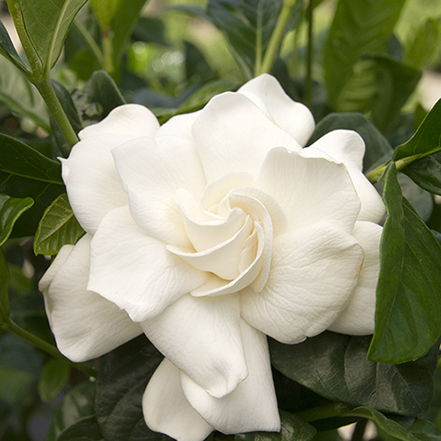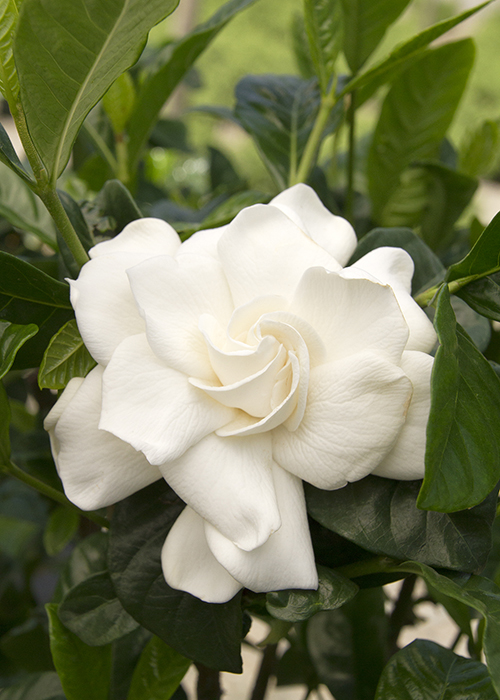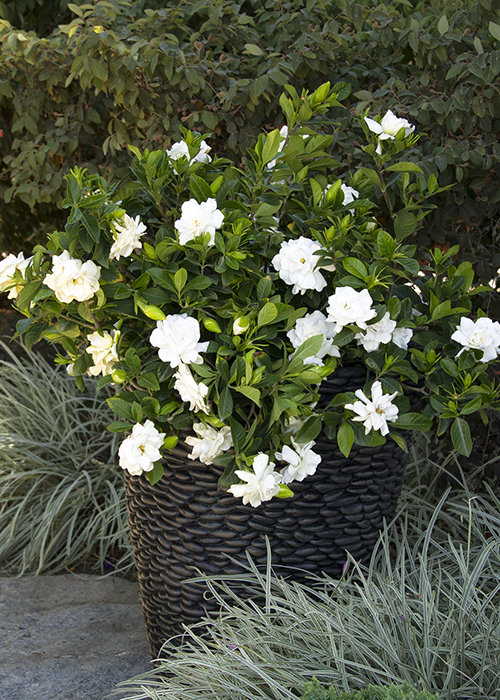If you live in a warmer zone, gardenias are among the most coveted garden treasures you can grow. Once planted in partial to full sun in organically rich, slightly acidic, well-drained soil, they thrive. Given a few years to settle, they bloom repeatedly from late spring through early summer. This tropical shrub is beloved by gardeners for its lush, green foliage and white, rose-like blooms with a delightful fragrance. With over 200 species native to various regions worldwide, gardenias have become popular for gardens and indoor spaces.
In this care guide, we'll explore how to grow and care for gardenias successfully. Whether you're a seasoned gardener or a novice who loves fragrant flowers, join us as we uncover the secrets to cultivating healthy gardenias!
At a Glance: Gardenia Care Basics
- Light: Gardenias thrive in full sun to partial shade, with shelter from intense afternoon sun.
- Soil: Plant in well-draining, acidic soil with a pH between 5.0 and 6.5.
- Water: Keep soil consistently moist but not soggy. Water deeply and regularly during the growing season.
- Temperature: Ideal temperature range is 65-70°F (18-21°C) during the day and 60-65°F (15-18°C) at night.
- Humidity: Gardenias prefer high humidity levels, around 60%. Use a humidifier or pebble tray for indoor plants.
- Fertilizer: Feed every 3-4 weeks during the growing season with an acidic, slow-release fertilizer or organic options.
- Pruning: Remove faded or dying flowers and prune to shape the plant or remove straggly branches. Avoid pruning in winter when buds are forming.
- Pests and Diseases: Watch for common issues like whiteflies, aphids, root rot, and powdery mildew. Address promptly with appropriate treatments.
- Potting and Repotting: Use a slightly larger container with drainage holes and a well-draining, acidic potting mix. Repot every 2-3 years.
- Hardiness: Most gardenias are hardy in USDA zones 8-11, but some varieties like Kleim's Hardy and Frostproof are hardy down to zone 7.
Grafted Gardenias: What are they?
Grafting is a horticultural technique that involves joining two plant parts together—the rootstock (lower portion) and the scion (upper portion)—to create a single plant with the best qualities of both. Monrovia is one of the only growers that offers a range of gardenia varieties expertly grafted onto Gardenia thunbergii rootstock, offering superior resistance to root-knot nematodes and more efficient nutrient uptake.
This process results in a plant that combines the beauty and fragrance of the desired gardenia variety with the vigor and resilience of the G. thunbergii rootstock, making grafted gardenias a superior choice for gardeners. Grafted varieties are especially beneficial in California gardens, where the dry air and native soil conditions making growing gardenias more challenging than in the southeastern United States.
If you've had trouble with gardenias, or want to ensure superior performance in your southern garden, consider trying one of these four varieties:
Everblooming
Gardenia (Grafted)
Smaller in size (so good for containers and borders) but with the same profusion of fragrant white blooms with glossy evergreen foliage. Partial to full sun. Up to 4′ tall and 3′ wide.
First Love®
Gardenia (Grafted)
Fragrant white blooms are larger than any other gardenia and the first to bloom. A superb evergreen landscape accent or container plant for courtyards or patio. Partial to full sun. Up to 8′ tall and 6 ‘ wide.
August Beauty
Gardenia (Grafted)
A prolific bloomer with large, double, sweetly fragrant, velvety white flowers. Medium sized, it’s ideal for mixed borders or a low hedge. Partial to full sun. Up to 5′ tall and 3′ wide.
Mystery
Gardenia (Grafted)
This most popular upright Gardenia is an excellent single specimen capable of scenting an entire courtyard or patio garden. Shady foundation? Wow. Partial to full sun. Up to 5′ tall and 3′ wide.
Top-Performing Non-Grafted Gardenia Varieties
August Beauty
Gardenia
This prolific bloomer showcases large, sweetly fragrant, velvety white flowers and lustrous evergreen foliage on a rounded shrub. Perfect for hedges, screens, or containers, it thrives in full to partial sun and moist, well-drained soil. Blooms from spring through fall. Up to 5' tall, 3' wide.
Everblooming
Gardenia
Highly prized for its profusion of sweetly fragrant, white blooms that make excellent cut flowers, this upright variety boasts glossy evergreen foliage. A terrific container plant for entryways or patios, it thrives in full to partial sun and moist, well-drained soil. Up to 4' tall, 3' wide.
Kleim's Hardy
Gardenia
This hardy dwarf gardenia is perfect for containers, raised beds, and border foregrounds. Its showy, white, star-like flowers emit a lovely fragrance, making it ideal for planting near entryways and patios. Up to 3' tall and wide. Hardy down to zone 7.
Mystery
Gardenia
This compact shrub stands out in any landscape, with its fragrant white flowers contrasting against glossy green foliage. Plant near entryways to enjoy its wonderful scent. Evergreen and fast-growing, 'Mystery' thrives in full to partial sun and moist, well-drained soil, blooming from late spring into summer. Up to 5' tall, 3' wide.
Frostproof
Gardenia
A wonderful flowering evergreen hedge or foundation plant, 'Frostproof' boasts lustrous, dark green foliage and large, fragrant, white flowers measuring 2 to 3 inches wide. More upright and sun-tolerant than other gardenias, its flower buds resist late spring frosts without damage. Up to 5' tall, 4' wide. Hardy down to zone 7.
First Love®
Gardenia
This gardenia boasts the largest blooms of any variety, with wonderfully fragrant, double white, 4 to 5-inch flowers. As the first gardenia to bloom in spring, it continues to flower well into the growing season. A superb compact evergreen accent shrub or container specimen, 'First Love' is perfect for entryways or patios. Up to 8' tall, 6' wide.
How to Care for Gardenias
Now that we've explored the different types of gardenias, let's dive into the essential aspects of gardenia care to help you keep these stunning plants thriving in your garden for years.
Planting Time and Location
The best time to plant gardenias depends on your location. Fall planting (six weeks before the first frost) is ideal in milder climates, while spring planting is better for areas with cooler winter temperatures.
When choosing a spot for your gardenia bushes, consider the following:
- Larger varieties need space to grow without competing for nutrients or being overcrowded
- Plant them high in the ground or on raised beds for better drainage
- Gardenias do well in large pots on decks and patios
- Avoid planting them as houseplants, as they attract pests like mites, mealybugs, and whiteflies
Sunlight Requirements
Gardenias thrive with four to six hours of sunlight daily, but there are some caveats:
- In warmer climates, protect them from intense late afternoon sunlight; morning to mid-day light is best
- Cooler regions can provide full sun exposure
Soil Conditions
Gardenias prefer acidic (5.0 to 6.5), organically rich, and well-draining loamy soil. To create the perfect soil conditions for your gardenia bushes:
- Amend your soil to increase acidity
- Add organically rich materials like compost, manure, ground bark, or sphagnum peat moss
Watering and Humidity
Proper watering and humidity are crucial for gardenias to flourish:
- Gardenias need an inch of water per week
- They prefer rich, acidic soil that doesn't stay too wet
- High humidity (around 60%) is essential to ward off spider mites; mist your gardenias during prolonged droughts
Temperature Considerations
Gardenias have specific temperature requirements:
- During the growing and blooming season, day temperatures between 65°F and 70°F and night temperatures between 60°F and 65°F are ideal
- They can't tolerate cold temperatures below 15°F and may get damaged or die if these cold temps linger
- Some varieties, like 'Frostproof', can be grown in Zone 7, where temperatures can dip to 10°F in the winter
Fertilizing Your Gardenias
To keep your gardenias healthy and vibrant, follow these fertilizing tips:
- Fertilize in early spring, after the last frost of the winter
- Feed plants every three to four weeks during the growing season
- Use an acidic, slow-release fertilizer, fish emulsion, blood meal, or coffee grounds
- Feed potted plants just as often and test soil pH levels to maintain good health
Pruning
To encourage continuous blooming, deadhead faded or dying flowers be removed about two-thirds down from the initial bloom. For younger gardenias, you can prune to shape the plant or remove straggly branches and spent flowers. However, be cautious not to prune during the winter months when buds are developing, as this can hinder the next season's bloom.
Providing your gardenias with the proper care they need will reward you with beautiful blooms and lush foliage. If you notice gardenia leaves turning yellow, it may indicate improper soil conditions, watering, or fertilizing, so be sure to assess and adjust your care routine accordingly.
Potting and Repotting Gardenias
Gardenias thrive in outdoor containers and can even be trained into stunning topiaries. When potting gardenias for the first time, choose a container that is slightly larger than the nursery pot and ensure it has proper drainage holes. Just like growing gardenias in the ground, they require acidic, well-draining, and evenly moist soil. When it comes to container gardening with gardenias, it's best to use a basic potting mix that is slightly acidic and well-draining.
To keep your potted gardenias healthy and vibrant, follow these steps:
- Add an acid plant fertilizer to the potting mix before planting your gardenia.
- Continue to feed your potted gardenia once a month to maintain soil fertility.
- Repot your gardenias every two to three years to refresh the soil and accommodate growth.
Common Gardenia Problems
While gardenias are beloved for their enchanting blooms and fragrances, they can sometimes face issues that affect their overall health and appearance.
Here are some common problems gardenia owners may encounter:
1. Yellow Leaves (Chlorosis)
- Caused by poor drainage, compacted soil, or nutrient deficiencies (particularly iron)
- Prevention: Plant gardenias in well-draining, acidic soil (pH 5.0-6.5)
2. Bud Drop
- Triggered by stress factors such as sudden changes in temperature, light, or water
- Prevention: Maintain consistent moisture and avoid moving the plant once buds have formed
3. Brown Leaves
- Indicates watering issues, environmental stress, or nutrient deficiencies
- Causes: Over or under-watering, exposure to extreme temperatures, poor soil drainage
4. Leaf Drop
- Caused by over-watering, under-watering, or low humidity
- Prevention: Maintain evenly moist soil and high humidity (use a pebble tray or humidifier for indoor plants)
5. Lack of Blooms
- Caused by insufficient light, incorrect pruning, or nutritional imbalances
- Prevention: Provide bright, indirect sunlight, prune at the right time, use a balanced fertilizer, and maintain acidic soil pH
Commonly Asked Questions About Gardenias
Why are my gardenia leaves turning brown?
Improper watering, extreme temperatures, poor drainage, or nutrient deficiencies can cause brown leaves on gardenias. To prevent brown leaves, ensure consistent moisture, protect from harsh weather, and maintain well-draining soil. If needed, use supplements like magnesium or iron.
What are some hardy gardenia varieties suitable for colder climates?
'Kleim's Hardy' can tolerate temperatures down to 10°F (-12°C) and is suitable for USDA zones 7-10. 'Frostproof' is another cold-tolerant option that can be grown in zone 7.
How often should I fertilize my gardenias?
Fertilize gardenias every 3-4 weeks during the growing season using an acidic, slow-release fertilizer or organic options like fish emulsion, blood meal, or coffee grounds. For potted gardenias, monitor soil pH to maintain a range of 5.0 to 6.5.
Get More Plant Care Tips and Guides
- Sign up for the Grow Beautifully Newsletter. You'll get gardening tips, design advice, free digital guides, and live webinar invites. Plus, new, exclusive plant information is delivered straight to your inbox twice a month.
- All About These Fragrant "Grafted" Gardenias
- Our Top 10 Gardening Tips
- Guide to Pruning Flowering Shrubs
- Find the Best Plants for Your Garden
- Pruning Ornamental Grasses
- Inspiring Garden Ideas
- Check out the "Garden Tips" section of the blog. Here, you can find care guides and garden tips on various plants.





